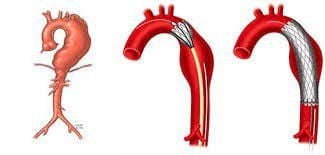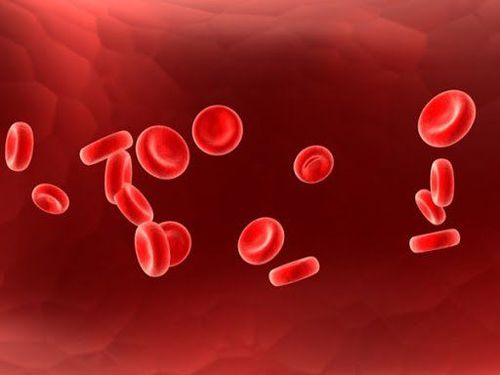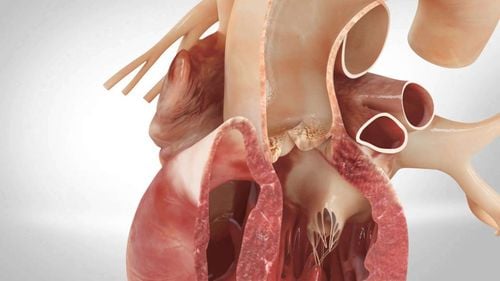This is an automatically translated article.
The article was consulted with Dr. Tran Hong Nhat - Interventional Cardiologist - Cardiovascular Center - Vinmec Central Park International General Hospital.Abdominal aortic segment replacement surgery is a vascular surgery indicated in cases where the abdominal aortic aneurysm is at risk of rupture or rupture.
1. Indications for surgery to replace the abdominal aorta below the kidney
The aorta is the largest artery that carries blood to all parts of the body. When the aorta goes to the abdomen, it is called the abdominal aorta.An aortic aneurysm is an irreversible dilation of the artery wall with a diameter greater than 50% of the normal size of the artery. Up to 80-85% of aortic aneurysms occur below the origin of the renal arteries, called subrenal abdominal aortic aneurysms.
There are many causes of aortic aneurysm such as:
Degenerative arterial wall due to diseases such as arteriosclerosis, fibrous dysplasia, drug-induced necrosis of the artery wall,... Aneurysms Aneurysms caused by bacterial, viral, non-infectious inflammation,... Aneurysms after trauma and wounds, aneurysms after arterial stenosis,... Aneurysms caused by some congenital diseases such as Marfan syndrome, Ehlers-Danlos syndrome, etc. Abdominal aortic aneurysms, if left untreated, will always tend to gradually enlarge. The enlarged sac can compress surrounding organs, affecting the function of these organs. The compression of the aneurysm also causes lack of blood to nourish the peripheral tissues of the aneurysm. The most dangerous complication of an aortic aneurysm is rupture of the aneurysm, which is a serious threat to the patient's life.
Surgery to replace the aneurysm of the lower abdominal aorta with an artificial vessel is indicated in the following cases:
Abdominal aortic aneurysm with a diameter of more than 2.5 times the diameter of the upper neck or more than 5cm. Abdominal aortic aneurysms have complications such as infection, threatened rupture, rupture, and embolism of the extremities. Stage II or more severe limb ischemia in Leriche syndrome. Surgery is not performed when the patient's physical condition does not allow it, the patient is too old and weak, or has many severe medical co-morbidities. For patients with gastrointestinal cancer, the doctor must carefully consider the risk factors before performing the procedure.

2. Surgical procedure to replace the abdominal aorta below the kidney
2.1. Preparing for surgery
Before surgery, the patient and family will be clearly explained by the medical staff about the condition, the purpose of the surgery, the possible complications and sequelae due to the disease, the surgery, the medical process. anesthesia, anesthesia or due to the patient's physical condition.To prepare for surgery, the patient will be carried out a number of necessary tests such as: chest X-ray, electrocardiogram, echocardiogram, respiratory function measurement, blood count test, group blood test. blood, blood clotting function, liver and kidney function tests, electrolytes, urine tests,...
Patients will be fostered, improve their physical condition, and balance disorders as a result of the disease. disease or due to location, chronic disease, age. Blood transfusion if the patient is severely anemic. Except for emergency surgery, medical diseases such as diabetes, hypertension, ... will be treated stably before surgery. The patient will have to fast for at least 8 hours before the surgery, the medical staff will guide the patient to remove, clean the surgical area and the whole body. May or may not use prophylactic antibiotics before surgery to prevent infection.
2.2. Steps to take
The patient lies supine on the operating table, with a pillow across the breastbone. Anesthesia team conducts endotracheal anesthesia, urinary catheterization, gastric bypass, central intravenous line for monitoring and rehydration when necessary. Blood pressure, electrocardiogram are continuously monitored on the monitor. Then the surgical team disinfected, exposing the entire abdomen and two groins, spreading the acid.Surgical steps:
Laparotomy of the white line between the upper and lower umbilicus, evaluate the abdominal organs (have tumors, ulcers or diverticula,...) The doctor removes the intestines from the surgical field, keeps warm and Anti-strain when the intestines are taken out of the abdomen. Then, open the leaf peritoneum to the site of the duodenojejunal ligament, and flip the angle of treitz and D4 of the duodenum to expose the abdominal aorta adjacent to the renal artery. Expose the site of inferior vascular replacement depending on the aneurysm morphology or the length of the occluded vessel. May expose the abdominal aorta at the iliac junction, the main iliac artery, the external iliac artery, or the bilateral common femoral artery. The patient received a systemic injection of Heparin at a dose of 50 IU/kg. The doctor clamps the blood vessels above and below the lesion and replaces the abdominal aorta: In case of aneurysm: the doctor opens the abdominal aorta along the aneurysm, stitches to stop the bleeding of the vertebral arteries. Replace the damaged artery with a straight or Y-shaped artificial vessel, depending on the case, and stitch the blood vessels. Angioplasty to remove atherosclerotic plaques at the anastomosis. Restore circulation to the inferior mesenteric artery if left colonic ischemia is suspected. After replacing the artificial vessel, the doctor sews the shirt of the aneurysm to cover the artificial vessel.
In the case of a patient with Lerich syndrome: the doctor did not open the artery, but clamped and sutured the blocked artery, the next steps of the technique to replace the artery were carried out as in the case of an aneurysm.
Surgeon will perform drainage if necessary. Then suture the parietal peritoneum, clean, arrange the intestines, close the incisions to finish the surgery.

3. Complications may be encountered after surgery to replace the abdominal aorta below the kidney
Bleeding is a common complication, if there is a hemodynamic disorder, the patient will be indicated for emergency hemostasis surgery. Postoperative embolism: There are many possible causes of post-operative embolism such as failure to fully treat the injury, inappropriate use of anticoagulants or poor suturing techniques. The doctor will appoint a re-surgery to restore the patient's blood circulation. Infections of various degrees, can be local or systemic infections, from mild to severe. Management includes intermittent suture removal, vascular ligation and bypass surgery, reoperation,... Intestinal ischemia due to surgery affecting the inferior mesenteric artery and internal iliac artery on both sides, if inflammation is present. peritoneal peritoneum due to intestinal necrosis, the doctor will re-operate the bowel resection. Marrow ischemia due to surgical shutdown of the vertebral arteries, managed by rehabilitation therapy. Subrenal abdominal aortic dissection is considered the standard treatment for subrenal abdominal aortic aneurysms. However, artery replacement surgery is a major specialty surgery, with a long operative time, a high risk of complications and a high mortality rate. Currently, endovascular intervention (stent-graft) and Hybrid surgical techniques have gradually replaced the classic surgery in many cases.Vinmec International General Hospital with a system of modern facilities, medical equipment and a team of experts and doctors with many years of experience in medical examination and treatment, patients can rest assured to visit. examination and treatment at the Hospital.
Please dial HOTLINE for more information or register for an appointment HERE. Download MyVinmec app to make appointments faster and to manage your bookings easily.














